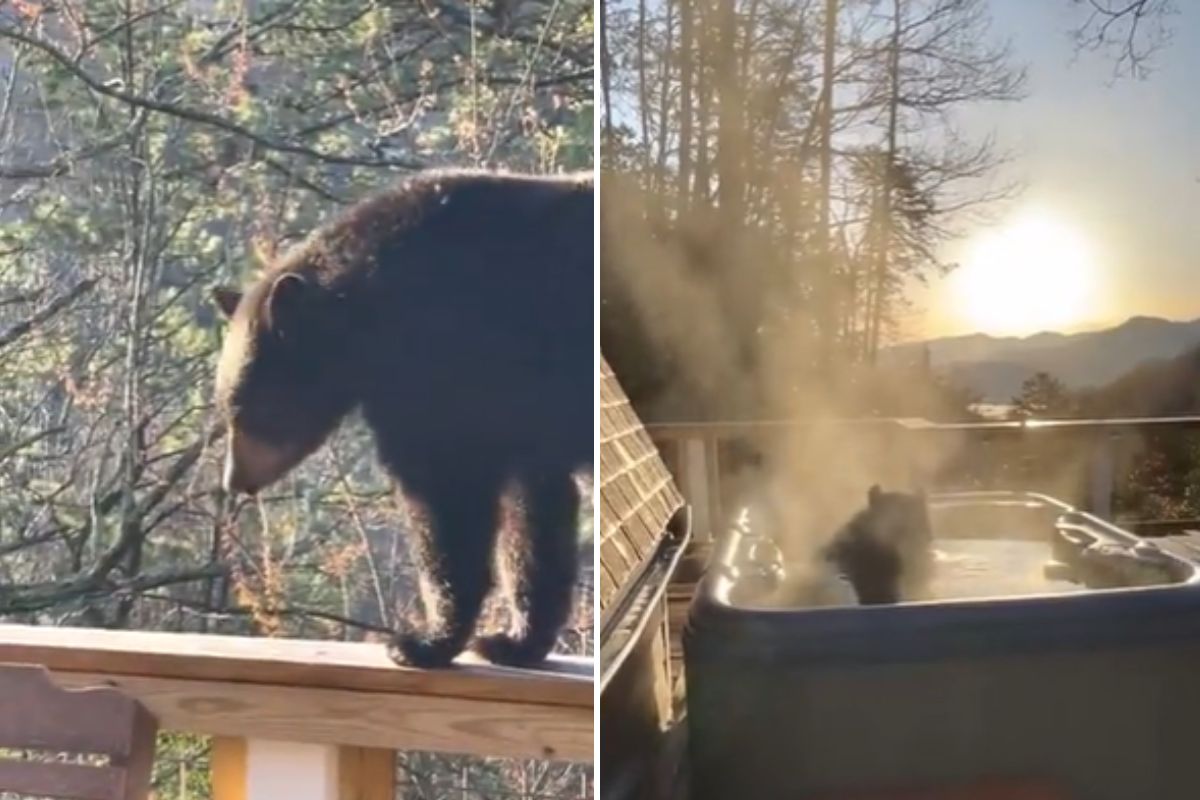As the snow melts and spring breathes new life into the Great Smoky Mountains, one of the most anticipated events of the season is the reemergence of black bears from their winter dens. This year, the region has already witnessed some extraordinary bear encounters, each offering a rare glimpse into the lives of these fascinating creatures.
A Bear’s Relaxing Dip in Gatlinburg
Imagine you’re on a vacation in Gatlinburg, Tennessee, soaking in the serenity of the mountains. But then, a black bear decides to join the party—by hopping into your hot tub! That’s exactly what happened to Todd Trebony, who managed to capture the moment on video. The bear, seemingly unfazed by the presence of humans, made itself at home, lounging in the hot tub as if it were a regular guest at the cabin.
For many, this encounter might seem surreal, but it’s not entirely surprising. According to the Tennessee Wildlife Resources Agency (TWRA), a healthy male black bear in Tennessee can be between 4-7 feet long and weigh as much as 500 pounds. With their territories expanding and human development encroaching further into their natural habitats, such interactions are becoming more common.
The video of the bear enjoying the hot tub quickly went viral, sparking a range of reactions online. Some viewers were amused by the bear’s casual demeanor, while others couldn’t help but joke about the bear needing some self-care after a long winter. One user quipped, “He’s going to take the most relaxing dip in that hot tub,” while another remarked, “That bear is living better than me!”
While the sight of a bear in a hot tub might be amusing, it’s also a reminder of the thin line between human and wildlife interactions in the Smokies. The TWRA advises that while black bears are usually tolerant of humans, they should always be treated as wild animals. As cute and curious as they may seem, bears can be unpredictable, and it’s crucial to keep a safe distance.
A Predatory Encounter in Cades Cove
In another rare and dramatic encounter, Philip Talbot and a friend were driving back to their cabin in Gatlinburg after a day spent exploring Cades Cove. As they approached a bend in the road, they witnessed a black bear in the process of hunting a wild hog. The bear, determined and relentless, was dragging the hog up an embankment near the road, clearly exhausted from the struggle.
Talbot, an avid hunter himself, described the scene as one of the most intense and surreal moments he had ever witnessed. “It was really a right place, right time,” he said. “We were on our way back to our cabin in Gatlinburg and were the first ones to drive up on it.”
This encounter underscores the opportunistic nature of black bears, particularly in the spring when food sources are scarce. While black bears are omnivorous, with 90% of their diet consisting of vegetation, they won’t pass up the chance to hunt if the opportunity arises—especially after the long, lean winter months.
Understanding Black Bear Behavior in the Smokies
Springtime in the Smokies is a critical period for black bears. Having just emerged from their winter dens, they’re on the lookout for food, covering large territories in search of sustenance. This period, before the major spring green-up, is when bears are most active and most likely to be seen by humans.
The TWRA and the BearWise program offer important guidelines for residents and visitors to ensure their safety and the safety of the bears. One of the key reminders is to avoid giving bears access to human food sources. This includes securing garbage containers, removing bird feeders, and not leaving pet food outdoors. As Matt Cameron, a spokesman for the TWRA, explains, “Bears are very curious animals, but this curiosity should not be confused with aggression. However, if they become accustomed to finding food near humans, they can become a nuisance or, worse, dangerous.”
In addition to being careful with food, it’s important to recognize and understand bear behavior. Black bears are generally not aggressive towards humans and will often go out of their way to avoid contact. However, their behavior can be unpredictable, especially if they feel threatened or are protecting their young.
If you encounter a black bear, it’s crucial to remain calm and avoid startling it. Bears will often try to appear larger when threatened by turning sideways, making woofing and teeth-clacking sounds, and slapping the ground with their paws. These are warning signs that you should slowly back away and leave the area.
The Growing Popularity of Bear Encounters
The Smokies are home to an estimated 72,000 black bears, and as human activities continue to expand into bear habitats, encounters like these are likely to become more common. For many, these encounters are thrilling and provide a unique connection to nature. However, they also serve as a reminder of the importance of coexistence and respect for wildlife.
As videos and stories of these bear encounters circulate online, they have become viral sensations, capturing the imagination of people around the world. From the humorous to the harrowing, each encounter tells a story of the delicate balance between humans and the wild.
Whether it’s a bear taking a leisurely soak in a hot tub or a dramatic hunt in the woods, these moments offer a window into the life of one of the Smokies’ most iconic residents. As we continue to share these stories, it’s essential to remember the responsibility that comes with living and recreating in bear country. By following guidelines and staying informed, we can ensure that these encounters remain safe and memorable for both humans and bears alike.






